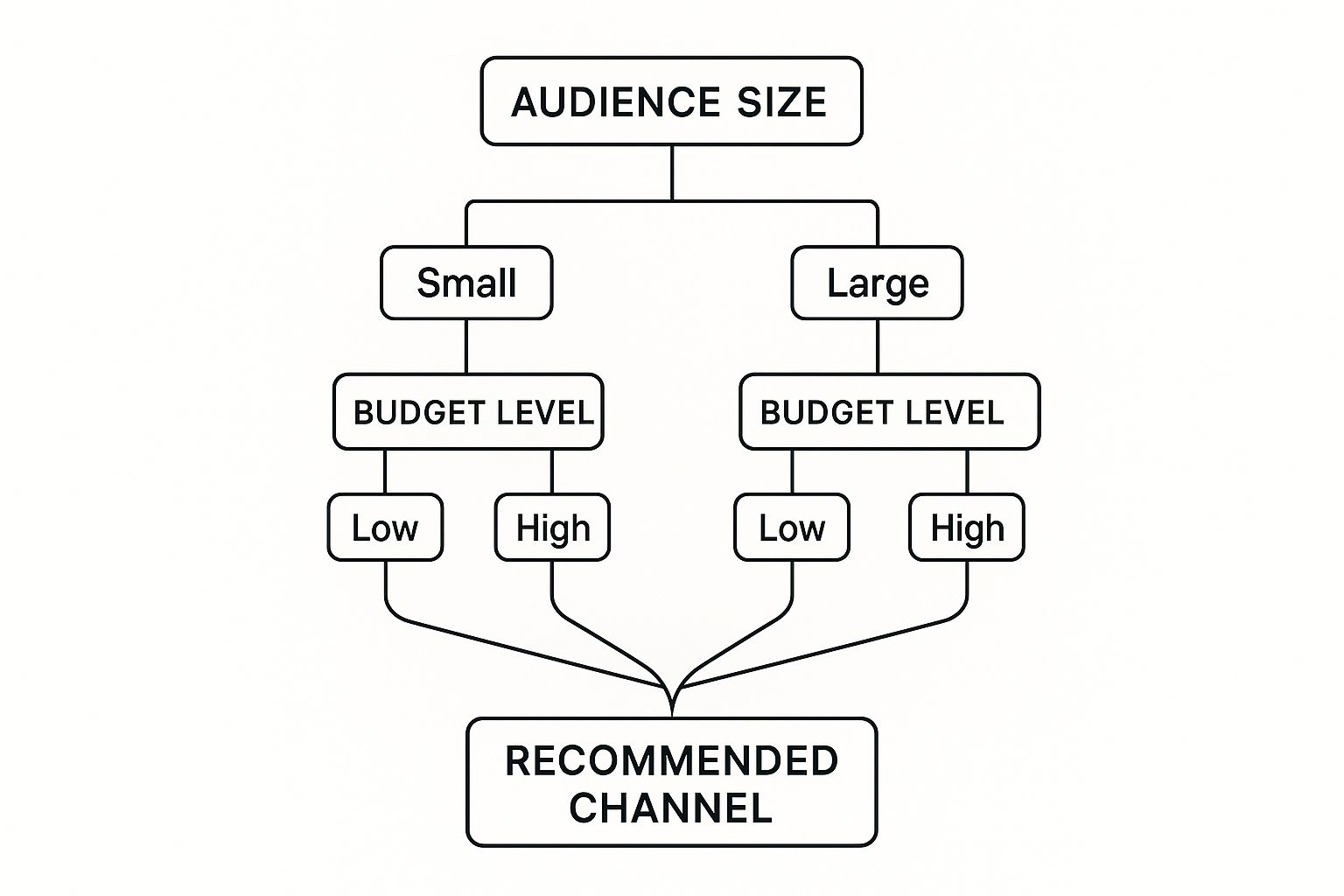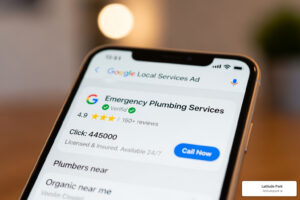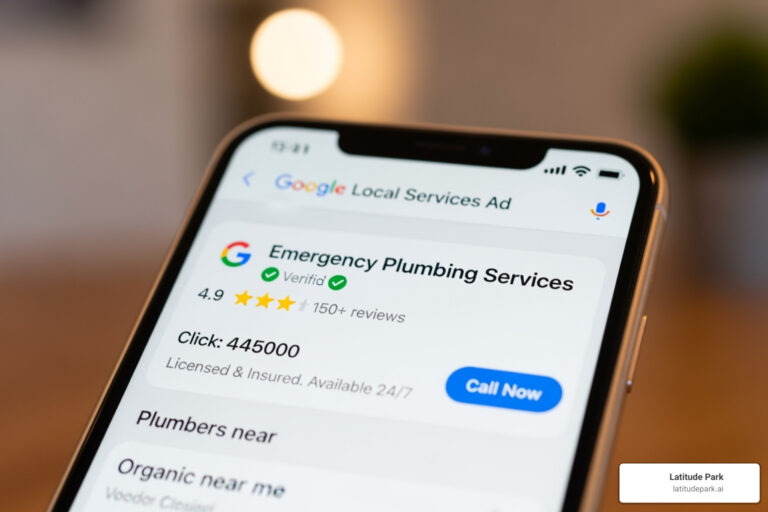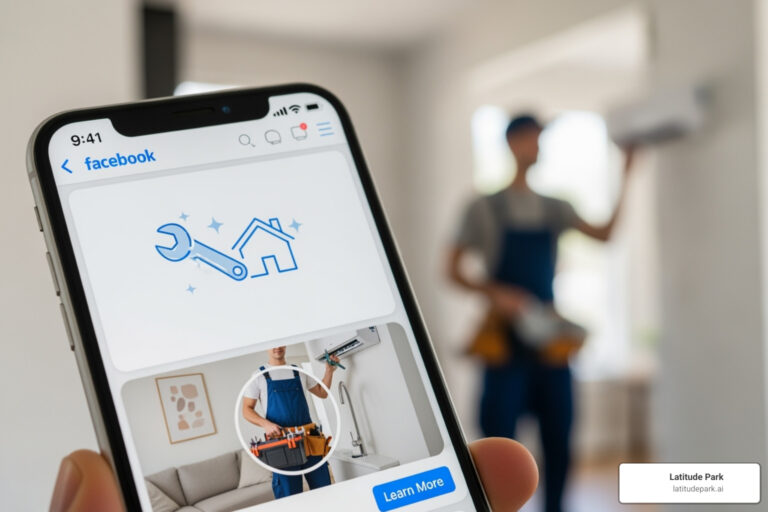Think of content marketing as the art of attracting customers by giving away valuable information for free. For a small business, this means creating things like blog posts, videos, or social media updates that genuinely solve your audience's problems. It’s a complete shift away from the hard sell; instead, you’re playing the long game, focused on building relationships and trust. Do this consistently, and you become the go-to authority in your field. A practical example would be a local accounting firm writing a blog post titled "5 Common Tax Deductions Small Business Owners Miss." This content doesn't sell their services directly; it offers free, valuable advice that builds trust.
Why Content Marketing Is Your Secret Weapon
It’s easy for a small business to feel outgunned in a world where big brands have bottomless advertising budgets. How can you possibly compete when you can’t shout louder than everyone else?
Simple: you stop shouting and start conversing. That’s the entire philosophy behind content marketing. Instead of interrupting people with ads, you draw them in by offering genuine help.
Think of it like this: traditional advertising is a megaphone, blasting the same message to a faceless crowd. Content marketing is a one-on-one conversation where you listen to someone’s problem and offer a thoughtful solution. For instance, a local gym's Facebook ad (megaphone) might just announce a membership sale. Their content marketing (conversation) would be a series of Instagram Reels demonstrating proper form for common exercises, answering a real need for their audience.
Building Trust Over Buying Attention
When a potential customer hops on Google, they aren't looking for an ad—they're looking for an expert. By creating content that actually answers their questions, you position your business as a credible, trustworthy resource long before they're ready to make a purchase.
It's about building that foundation of trust first. For instance, a local bakery could write a blog post on "How to Choose the Perfect Cake for a Kid's Birthday Party." That content is incredibly helpful to local parents, establishes the bakery's expertise, and builds a real connection with people who might need a cake very soon.
A More Cost-Effective Path to Growth
This trust-building approach isn't just a feel-good strategy; it’s also incredibly efficient. Content marketing is a financial game-changer for small businesses trying to keep up with traditional advertising. In fact, studies show that content marketing costs about 62% less than outbound methods like TV ads or trade shows, yet it generates three times as many leads.
This efficiency comes from focusing on inbound marketing, where your audience finds you organically because you’re providing value. You can dig into more content marketing statistics to see just how powerful this is.
The real magic is that a single great piece of content, like a well-written blog post, can keep attracting new customers for years after you hit publish. It works for you 24/7 with no ongoing ad spend.
Leveling the Playing Field
At the end of the day, content marketing levels the playing field. It allows you to compete based on the value and expertise you provide, not the size of your bank account. By focusing on creating genuinely helpful, high-quality content, you can:
- Attract Your Ideal Audience: Your content acts like a magnet for the exact people you want to serve, naturally filtering out those who aren't a good fit. For example, a high-end interior designer creating content about sustainable luxury materials will attract clients who value that, rather than those looking for a budget makeover.
- Establish Authority: When you consistently share what you know, you prove you're an expert in your field. It's that simple.
- Nurture Lasting Relationships: You're not just making a sale; you're building a community of loyal fans who trust your advice and will choose you when they’re ready to buy.
Building Your Strategic Content Foundation
Jumping into content marketing without a plan is like building a house without a blueprint. Sure, you might end up with something, but it probably won't be the sturdy, functional home you envisioned. A solid foundation ensures every single piece of content you create serves a distinct purpose, moving your business closer to its goals.

This strategic approach is what separates effective marketing from wasted effort. Instead of randomly writing blog posts or filming videos hoping something sticks, you'll create content that systematically attracts the right people and solves their very specific problems.
Pinpoint Your Target Audience
Before you write a single word, you have to know exactly who you're talking to. The most successful content marketing for a small business is hyper-focused on a specific customer. Forget trying to appeal to everyone; your goal is to become the go-to resource for a well-defined niche.
The best way to do this is by creating a simple customer persona. This is just a fictional profile of your ideal client. Think beyond basic demographics and really dive into what makes them tick.
- What are their biggest daily challenges related to your industry? A plumber’s persona might be a homeowner who constantly struggles with DIY fixes gone wrong. Their key pain point is the frustration and wasted weekends.
- What questions are they typing into Google? They're likely searching for "how to fix a clogged drain without chemicals" long before they ever search for "plumbers near me."
- Where do they spend their time online? Are they getting advice from local Facebook parenting groups, scrolling through Pinterest for home renovation ideas, or looking for professionals on LinkedIn?
Answering these questions transforms your content from a generic broadcast into a personal, helpful conversation. You start addressing real pain points, which is the absolute key to building trust and authority.
Set Goals That Drive Real Business Growth
Your content needs a job to do. Without clear objectives, you're just creating noise online. The best way I've found to set meaningful goals is by using the SMART framework—ensuring they are Specific, Measurable, Achievable, Relevant, and Time-bound.
This simple framework turns vague wishes into actionable targets. Instead of saying, "I want more traffic," a SMART goal sounds like this: "Increase organic blog traffic by 20% in the next three months by publishing one new, SEO-optimized post per week." See the difference?
A documented strategy is a game-changer. Research shows that 80% of highly successful companies in content marketing have a documented strategy, while over half of unsuccessful ones do not. Writing your goals down makes them real and holds you accountable.
Here are a few practical SMART goals a small business could set:
- Generate 15 new email subscribers each month from our blog content for the next quarter by adding a compelling "free checklist" download to our top three posts.
- Increase engagement on our Instagram Reels by 25% over the next 60 days by posting two educational videos per week that answer common customer questions.
- Rank on the first page of Google for three new local keywords (e.g., "best coffee shop in downtown Austin") within six months.
Each goal is directly tied to a business outcome, making it crystal clear whether your content marketing is actually working or just spinning its wheels.
Uncover What Your Audience Is Searching For
Once you know your audience and your goals, it's time to find the exact phrases they use to find solutions online. This is called keyword research, and it’s the bridge between what your customers desperately need and the content you create. The good news? You don't need expensive software to get started.
Free tools like Google's Keyword Planner or even just typing ideas into the Google search bar and looking at the "People also ask" section can reveal a goldmine of topics. A practical insight: if you run a pet grooming business and see "how to trim dog's nails at home" in the "People also ask" section, that is a perfect topic for a blog post or a short video. It addresses a real fear your customers have and positions you as a helpful expert.
My advice is to focus on long-tail keywords—these are longer, more specific phrases like "how to choose a bike for city commuting" instead of a broad term like "bikes." These phrases generally have less competition and are used by people much closer to making a decision. For small businesses looking to expand their output without stretching resources thin, it's also worth exploring strategies for scaling content creation with AI. By aligning your content with these keywords, you ensure your hard work gets seen by the right people at the right time.
Creating Content That Connects and Converts
Once your strategy is locked in, it’s time for the fun part: creating content that actually helps people. This isn't about pumping out generic articles or chasing viral trends. It's about crafting genuinely useful resources that solve real problems for your audience, building deep trust that naturally brings them closer to your business.
The goal here is to stop being just a seller and start being the trusted expert. When you shift from vendor to mentor, you transform one-time buyers into loyal fans who will champion your brand.
Find the Right Content Formats
The secret to content marketing for a small business is picking the formats that play to your strengths and fit how your audience consumes information. You don’t need to be everywhere at once. It's far better to master one or two channels than to spread yourself thin across five.
Let's look at a few core formats that consistently get results for small businesses.
- Consistent Blogging: Think of your blog as your digital home base. It’s an incredibly powerful tool for building authority, answering customer questions in a detailed way, and pulling in long-term organic traffic from search engines. Every post you publish becomes a permanent asset, working for you 24/7.
- Short-Form Video: Platforms like Instagram Reels and TikTok are unbeatable for showing off your brand's personality and serving up quick, easy-to-digest tips. Video makes your business feel more human, approachable, and real.
- Engaging Social Media: Use platforms like Facebook or LinkedIn to do more than just post updates—use them to build a community. Share behind-the-scenes looks, ask thoughtful questions, and start conversations that make your followers feel like they're part of your story.
Practical Examples You Can Use Today
To make this real, let’s see how different small businesses could put these formats into action. Remember, the focus is always on being helpful, not just promotional.
Picture a local plumber. Instead of just running ads that say "Call Us Now," they could create:
- A 60-second video showing how to fix a common leaky faucet using basic tools from the hardware store, with clear, step-by-step visuals.
- A blog post titled "5 Warning Signs Your Water Heater Needs a Check-Up (And How to Avoid a Cold Shower)."
- An Instagram Story poll asking homeowners: "What's your single biggest plumbing headache: A) Clogged Drains B) Low Water Pressure?"
Or what about a financial advisor? Their content could look like this:
- A blog post on "How to Start Investing with Just $100," breaking down micro-investing apps and ETFs.
- A short video busting a common myth about retirement savings, like "You need millions to retire comfortably."
- A LinkedIn post sharing a quick, anonymous case study: "How we helped a client consolidate their debt and boost their credit score by 50 points in 6 months."
Every single piece of this content solves a specific problem, building credibility and a relationship long before a sale is ever on the table. The huge value here is in building trust and authority, and you can learn more about the benefits of content marketing campaigns for your business.
This infographic gives you a simple way to decide which channel to focus on based on who you're trying to reach and what your budget looks like.

As the visual shows, even with a smaller budget, you can still make a big impact by creating targeted content for a specific, niche audience.
A smart content strategy is a living thing, not a "set it and forget it" task. To help you choose the best format for your goals, here’s a quick guide.
Choosing the Right Content Format for Your Goals
This table is designed to help you match your marketing goals with the right type of content, keeping in mind the time and effort each one requires.
| Content Format | Primary Goal | Best For | Example for a Small Business |
|---|---|---|---|
| Blog Posts | SEO & Authority | Answering in-depth questions, building long-term traffic, and establishing expertise. | A local bakery writes "The Ultimate Guide to Sourdough Starters for Beginners," complete with a feeding schedule. |
| Short-Form Video | Engagement & Brand Personality | Showcasing products in action, offering quick tips, and connecting on a human level. | A fitness studio posts a 30-second Reel showing three common mistakes to avoid during a squat. |
| Email Newsletters | Nurturing Leads & Building Loyalty | Sharing exclusive content, promoting special offers, and staying top-of-mind with interested customers. | A bookstore sends a weekly email with staff book recommendations, author interview snippets, and news about in-store events. |
| Case Studies | Building Trust & Driving Conversions | Proving your value with real-world results and helping potential clients see themselves in your success stories. | A web designer creates a page showing how they increased a client's online sales by 40% with a website redesign, including before-and-after screenshots. |
By strategically choosing your formats, you can make sure every piece of content you create is working as hard as possible to grow your business.
Getting Your Content Seen by the Right People
Creating amazing content is a huge achievement, but it's only half the battle. Think about it: if that brilliant article or helpful video just sits on your website, it can’t build trust, attract customers, or grow your business. This is where a simple, focused distribution strategy comes in—a plan to get your hard work in front of the right eyeballs at the right time.

As a busy small business owner, the key is to be strategic, not exhaustive. You don't need to be everywhere. Instead, you can make a massive impact by focusing your energy on three high-leverage channels that work together to create real momentum.
Start with On-Page SEO for Long-Term Discovery
Search Engine Optimization (SEO) is your long-term growth engine. Think of it as setting up your content to be discovered by Google for months, or even years, after you hit "publish." And the good news? You don't need to be a technical wizard to get started with the on-page SEO basics.
First, make sure every blog post is built around a specific keyword or phrase your customers are actually searching for. Then, you just need to sprinkle that keyword naturally into a few key places.
- The Page Title: This is the headline that shows up in Google search results. For a post about fixing a faucet, a good title would be "How to Fix a Leaky Faucet in 5 Easy Steps." It's clear, includes the keyword, and promises a simple solution.
- The Meta Description: This is the short snippet of text under your title in the search results. A practical example: "Stop that annoying drip! Our simple guide shows you how to fix a leaky faucet with basic tools. Save money and get it done in under 30 minutes."
- Within the Content: Weave your keyword and related phrases (like "dripping tap" or "faucet repair") into your headings and paragraph text where it sounds natural and adds value for the reader.
These simple steps tell search engines exactly what your content is about, helping them show it to the right audience. For a deeper dive into growing your business online, check out these small business digital marketing tips to drive leads and sales.
Nurture Your Audience with Email Marketing
While SEO is fantastic for attracting new people, email marketing is your direct line to your most engaged audience. These are the folks who have already raised their hand and said, "I'm interested." They subscribed because they value what you have to say.
Don't let that relationship go cold. Every time you publish a new piece of content—a blog post, a how-to video, a case study—share it with your email list.
Your email list is one of your most valuable business assets. Unlike social media followers, you own this list. This gives you a direct, reliable way to communicate with prospects and customers without worrying about changing algorithms.
For example, a local accounting firm that publishes a blog post on "Quarterly Tax Tips for Freelancers" should immediately send a newsletter to their subscribers with a subject line like, "Don't Miss These 3 Tax Tips for Q3!" and link directly to the article. This simple action drives instant, high-quality traffic and reinforces their expertise with an audience that's already primed to listen.
Maximize Reach on One or Two Social Platforms
Spreading yourself thin across every social media platform is a recipe for burnout. The secret to effective social media for a small business is to be selective. Go back to your customer persona—where do they actually spend their time online? Pick the one or two platforms that matter most and go all-in there.
Once you’ve chosen your channels, focus on repurposing your core content. A single blog post can be transformed into multiple social media updates.
Here’s a practical checklist for a blog post titled "5 Ways to Improve Your Home's Curb Appeal":
- Create an Eye-Catching Graphic: Use a tool like Canva to make a simple, branded image featuring a beautiful front yard and the post title. Share this on Facebook and Pinterest.
- Pull Out Key Quotes: Create five separate graphics, each with one of the five tips (e.g., "Tip #1: A Fresh Coat of Paint on the Front Door"). Schedule these to post on Instagram over a week.
- Film a Short Companion Video: Record a quick 60-second video showing yourself walking around a house, pointing out the five improvements. Share this as an Instagram Reel or TikTok.
- Ask an Engaging Question: Post on Facebook: "We just shared 5 ways to boost curb appeal. What's the #1 thing you've done that made the biggest difference for your home?"
By focusing your efforts, you ensure that every piece of content you create gets the visibility it deserves, turning your hard work into tangible business results.
Measuring Success Without Drowning in Data
You've poured your heart and soul into creating helpful blog posts and engaging videos. But how do you actually know if any of it is working? Measuring success is a non-negotiable part of any content marketing for small business plan, but it’s shockingly easy to get lost in a sea of charts and numbers.
The trick is to zero in on a few core metrics that tie directly back to what you're trying to achieve in your business.

Think of your data as a compass, not a dense instruction manual. It’s there to give you direction, showing you what to do more of and what needs a little tweaking. By keeping an eye on the right numbers, you can turn your content efforts into a predictable engine for growth.
Key Metrics That Actually Matter
For a small business, a handful of metrics will tell you almost everything you need to know. You don't need fancy, expensive software to get started—a free tool like Google Analytics is more than powerful enough to give you the essential data.
Here are the vital signs of your content’s health:
- Website Traffic: This is the most basic pulse check. Are more people visiting your site over time? A practical insight is to look at the "Acquisition" report in Google Analytics to see if traffic from "Organic Search" is growing month-over-month. That's a direct sign your SEO efforts are working.
- Time on Page: This tells you if people are actually reading or watching what you’ve created. A long "time on page" for a blog post (e.g., over 3 minutes) is a fantastic sign that your content is engaging and hitting the mark.
- Conversion Rate: This is the big one. It measures how many visitors take the action you want them to, whether it's signing up for your newsletter, filling out a contact form, or downloading a guide. For example, if 100 people visit a blog post and 5 sign up for the newsletter, your conversion rate for that goal is 5%.
The real magic happens when you connect these numbers back to your business goals. If a specific blog post has a high "time on page" and drives a ton of newsletter sign-ups, that's a blinking neon sign telling you to create more content just like it.
From Data to Actionable Insights
Just collecting data is like having a bunch of ingredients but no recipe. You need to turn it into wisdom. The goal is to move beyond just knowing what happened and start understanding why it happened. This is where you find the practical, growth-driving opportunities.
Data tells you a story. A sudden spike in traffic from a specific social media channel tells you where your audience hangs out. A blog post with zero conversions tells you the call-to-action might need a complete rethink.
To really measure your content marketing's impact, focus on pulling actionable insights from your data. For example, if you notice one of your videos about "beginner yoga poses" is getting shared like crazy on Facebook, that's a crystal-clear insight: your audience is craving beginner-level content, and it's time to invest more in video for that platform. The ability to connect these dots is fundamental, especially as technology's role grows. You can explore more on the http://latitudepark.ai/importance-of-seo-in-the-age-of-ai/ to see how these strategies are evolving.
Tying Metrics to Your Bottom Line
At the end of the day, every metric you track should help answer one critical question: is this bringing in business? The landscape is always shifting, and you have to adapt. It's estimated that in 2025, about 67% of small businesses will be using AI tools in their marketing, and they typically spend around 7-10% of their revenue on marketing activities.
To justify that spend, they have to focus on performance indicators like customer acquisition cost (CAC) and return on ad spend (ROAS). A practical example is tracking how many people who downloaded your "Free E-book on Home Staging" ended up booking a paid consultation. If you spent $100 on promoting the e-book and it led to two new clients worth $1,000 each, your return is undeniable. This ensures their campaigns are not just creative, but profitable.
By focusing on a few key metrics and connecting them to real-world outcomes, you can confidently measure your success and make smarter decisions that fuel sustainable growth.
Common Content Marketing Questions Answered
Jumping into any new strategy brings up a lot of questions. When it comes to content marketing for a small business, I hear the same handful of concerns over and over again. Let's tackle these common hurdles head-on so you can move forward with total confidence.
The biggest worry? Money. Business owners often think they need a huge budget to even compete, but that’s one of the biggest myths out there. Your most valuable initial investment isn't cash—it's your time and what you already know about your business.
How Much Should a Small Business Spend on Content Marketing?
Look, there’s no magic number here. But a solid rule of thumb is to set aside 7-10% of your total revenue for all of your marketing efforts. Since content marketing is one of the most cost-effective things you can do, a good chunk of that can go right here.
If you're just starting out and the budget is tight, focus on what you can invest: your time. A practical starting point is to commit to writing one high-quality, 1,000-word blog post a week and sharing it on the one social media platform where you know your customers hang out. That's it. This time-based investment is your initial "spend."
As you start to see traction and bring in more revenue, you can reinvest it to scale things up. That might look like hiring a freelance writer for $200 per article, buying a video editing tool for $20/month, or putting $50 behind a Facebook post to boost its reach. The key is to start small, stay consistent, and track your return—that’s what justifies spending more down the road.
I Am Not a Writer. How Can I Create Good Content?
You don't have to be the next Hemingway. You just need to be an expert in your field—and guess what? You already are. The absolute best content ideas are hiding in plain sight: they're the questions your customers ask you every single day.
Your job is to simply document the answers. Think about it: every time you explain to a client why they need to rotate their tires or answer an email about the best time to plant tulips, you've basically created a perfect outline for a piece of content.
Authenticity and usefulness are far more important than perfect prose. Your audience is looking for solutions from a real person, not an English professor. Focus on being genuinely helpful, and your audience will connect with you.
And if writing really isn't your thing, don't force it. Lean into other formats that play to your strengths:
- Film a quick "how-to" video on your smartphone. A dog groomer could film a 2-minute tutorial on how to properly brush a golden retriever. It doesn't have to be fancy.
- Start a simple podcast using a free tool like Anchor.fm. An insurance agent could record a 15-minute weekly episode talking about common claims they see.
- Create visual guides or checklists using Canva. A wedding planner could create a "12-Month Wedding Planning Checklist" that's perfect for sharing on Instagram or Pinterest.
How Long Does It Take for Content Marketing to Show Results?
Content marketing is a marathon, not a sprint. This is probably the most important thing to understand. It’s not like running a paid ad, where you get an instant (but temporary) surge of traffic. Content marketing is about building a long-term asset for your business that pays dividends for years.
You'll likely see some early signs of life within a few weeks—maybe a little boost in social media engagement or a few new email subscribers. But for the big results, like a steady stream of organic traffic from Google and a reliable flow of leads, you need to think in terms of a 6 to 12-month timeline.
Why so long? Because it takes time for search engines like Google to find, index, and begin to trust your site. It also takes time for your audience to discover you and see you as a credible source. A practical insight: think of it like planting a tree. For the first few months, you're watering and nurturing it with consistent content, but you don't see much growth above the surface. After 6-12 months, the roots (your authority and SEO) are established, and the growth becomes much more visible and sustainable.
Ready to stop guessing and start growing? At Latitude Park, we build and manage powerful SEO and advertising strategies that drive real results for small businesses and franchises. Book a free consultation today and let's create a marketing plan that works for you.









